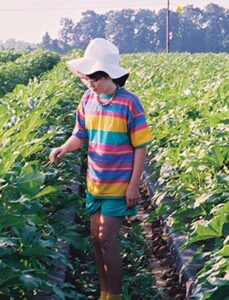A child’s fondness for gumbo, aka okra, can introduce formal school subjects informally and naturally in the home or school garden. One of the joys of gardening with children is growing edibles that match their food preferences. In the process of farming favorite foods, children learn history, science, math, nutrition, and problem solving.
History of Okra
Children are delighted to discover plants have nicknames, families, and histories just as people do. Okra, Abelmoschus esculentus, is also known as “gumbo” and “lady finger.” As a member of the mallow family, its close kin are cacao, cotton, hibiscus, hollyhock, and Rose of Sharon. Family resemblance is observable in the flowers and pods.
Okra originated in Africa and was first spotted along the Nile in Egypt in 1216. Did Cleopatra eat okra? Historians speculate slave trading first introduced okra to North America in the 1600s. The French brought okra to Louisiana. By 1748 there are reports of okra in Philadelphia, and Thomas Jefferson noted it growing in Virginia in 1781.
Okra did not become popular as a food until 1925 with the invention of frozen food and the introduction of more taste tolerant varieties like Clemson Spineless, a smooth skinned, green variety okra introduced in 1937. Okra has remained a southern traditional food and is still celebrated in festivals throughout the south such as the Okra Strut in Irmo each fall.
Varieties of Okra
Growing okra introduces children to the wide variation of color, textures, forms, and flavors of a single vegetable. Although ‘Clemson Spineless’ dominates the marketplace, an astounding variety of heirloom okras exist. Challenge children to grow an okra rainbow of pink, red, lime green, dark green, white, and yellow pods. They can grow okra with only three-inch pods (‘Star of David’) or up to 12-inch pods (‘Cow Horn’).
Online Catalogs for Okra www.rareseeds.com www.johnnyseeds.com www.epicgardening.com www.southernexposure.com www.parkseed.com
Science Tests For
Growing Okra
Children can conduct several tests in the process of growing okra. These tests transfer to growing other plants too.
Okra as a hot weather plant requires soil temperatures of 65-70 degrees at a four-inch depth for germination. Children can use a soil thermometer to test soil temperature before seeding. Throughout the growing season, retest soil temperature to compare with air and water temperatures in the garden noting differences in a solid, liquid, and gas.
Test and compare different methods to hasten germination of okra seed besides proper soil temperature. Try nicking or scarifying the seed, freezing the seed overnight, and soaking seed in warm water overnight. Which method works best?
Okra is very tolerant of poor soil but does best in well-drained sandy loam with a pH between 5.8-6.5. Introduce the pH scale and have children make a soil pH test with a kit. What amendments, if any, must be made to your soil? Follow up with a Clemson soil test and compare the two.
Mathematical Okra
The child acquires and applies measurement, number, and spatial relationships in the garden. Children sow okra seeds one inch deep and 12 to 24 inches apart or as directed on the seed package.
Once seeds are sown, children should record the date planted and the date seeds sprout on a calendar or in a journal. In how many days did seeds germinate? Does it compare with seed package information? What percentage of seeds germinated?
How tall will the plants get according to the seed package? How tall did your plants get? How long are the mature pods of different varieties? Very young children may use their body height or finger length to compare plant height and pod length while older children use standard measuring tools.
Graph the growth rate of each variety grown. Which variety flowered first? Compare the maturity dates of each variety. How many seeds are in the pods of each variety?
How many pounds of okra does each plant produce? Which variety produced the most okra by weight? By pod? By pod length?
A Container
Gumbo Garden
An alternative to planting okra directly into the ground is to plant in five-gallon food grade plastic buckets, one plant per bucket. Cut drainage holes into the bottom covering holes with newspaper to retain the soilless potting mix and compost.
Buckets have several advantages. They have handles and can be moved around and stay weed free. Root-knot nematodes will not affect okra in buckets. With each variety in its own bucket, one can isolate plants for experimentation and to control pests and diseases. Buckets make watering, picking-off pests, fertilizing, and harvesting easier for young gardeners. Children enjoy personalizing bucket gardens with names like “Planet of the Pods,” “Mellow Mallows,” and “Gumbo Rumba.”
Harvesting Gumbo
Gardeners learn the biggest mistake in growing okra comes at harvest time. Harvest takes trained observation of individual varieties to know prime picking time. Pods left on the plant too long will be tough, fibrous, and woody. Seed packages give maturity dates. Calendars should be marked at planting time as to when to expect to start harvesting the first crop.
Feasting on Okra
Okra pods should be picked just before preparing them and require no more than five minutes of cooking time. Pods retain maximum nutrients with minimum processing. Prepare okra by steaming or boiling, dipping in egg and cornmeal and frying, or adding as an ingredient in stews and soups. The gummy extract of cooked okra is considered “slimy” or “satisfying” depending on the person. Dissolve the extract by adding lemon juice or vinegar to the cooking water.
One serving of okra, nine pods, contains 25 calories, four grams of fiber, Vitamins A and C, and good amounts of beta-carotene, calcium, and potassium.
A season of gumbo gardening brings maturity to the crop and the young gardener.






Loading Comments